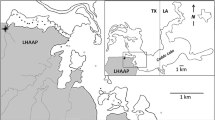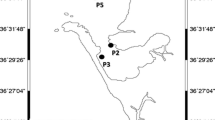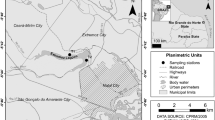Abstract
Sediment from 27 river sites in Northern Spain were tested with the aquatic oligochaete Tubifex tubifex (Annelida, Clitellata) 28-day chronic bioassay. Sampling sites were chosen from those established by regulatory water agencies for water-quality surveillance networks in rivers of the Basque Country and the Ebro basin. Inclusion of this test in an assessment programme with chemical and benthic community data currently collected by the water agencies will enable a more comprehensive ecotoxicological assessment. Cocoon and adult biomass were used as end points in addition to percent mortality, number of cocoons, young per adult, and percent of hatch end points as proposed in the American Society for Testing and Materials (ASTM) guidelines. Ecotoxicity assessment of the sediments was carried out by comparing mortality, growth, and reproduction in test sediments with their respective experimental control. Cluster analysis resulted in four groups of sediments that were compared using multidimensional scaling ordination (MDS), and the contribution of toxicity end points and the relationship of chemical variables to the MDS ordination space were assessed by principal component correlation (PCC). A gradient of sediments from nontoxic (4 controls and 6 sediments) to severely toxic (8 sediments) was observed, with all of the original biological end points contributing significantly to the ordination. The most toxic sediments could be separated into 2 groups based on the effects of pollutants on mortality (4 sediments) or on reproduction and growth (4 sediments). Remaining sites were grouped together as toxic sediments but showed a variable degree of sublethal effects. The acceptability criteria for validation of the bioassay, as recommended by the ASTM, measured in the control batch of each bioassay were achieved for survival and cocoon production (coefficient of variation [CV] and variability with regard to their average calculated through laboratory control charts). However, the ASTM criteria were found to be strict for the CV for total number of young, and a more realistic criterion is proposed. New criteria are also suggested to improve quality assurance of the bioassay, namely, a minimum number of cocoons per adult in the control group.





Similar content being viewed by others
References
Anlauf A (1994) Some characteristics of genetic variants of Tubifex tubifex (Müller, 1774) (Oligochaeta: Tubificidae) in laboratory cultures. Hydrobiologia 278:1–6
American Society for Testing and Materials (1994) Standard guide for conducting sediment toxicity test with freshwater invertebrates. ASTM E1383-94, Philadelphia, PA
Amercian Society for Testing and Materials (2005) Standard test method for measuring the toxicity of sediments-associated contaminats with freshwater invertebrates. ASTM E1706-05, Philadelphia, PA
Bailey R, Day KE, Norris RH, Reynoldson TB (1995) Macroinvertebrate community structure and sediment bioassay results from areas of North American Great Lakes. J Great Lakes Res 21:42–52
Bailey R, Norris RH, Reynoldson TB (2004) Bioassessment of freshwater ecosystems: Using reference condition approach. Kluwer Academic, Dordecht, The Netherlands
Beauchamp KA, Kathman RD, McDowell TS, Hedrick RP (2001) Molecular phylogeny of tubificid oligochaetes with special emphasis on Tubifex tubifex (Tubificidae). Mol Phylogenet Evol 19:216–224
Belbin L (1993) PATN, pattern analysis package. Division of Wildlife and Ecology, Commonwealth Scientific and Research Organization, Australia
Bettinetti R, Provini A (2002) Toxicity of 4-nonylphenol to Tubifex tubifex and Chironomous riparius in 28-days whole sediments tests. Ecotox Environ Safe 53:113–121
Burton GA, Norberg-King TJ, Ingersoll CG, Benoit DA, Ankley GT, Winger PV, et al. (1996) Interlaboratory study of precision: Hyalella azteca and Chironomus tentans freshwater sediment toxicity assays. Environ Toxicol Chem 15:1335–1343
Burton GA, Batley GE, Chapman PM, Forbes VE, Smith EP, Reynoldson TB, et al. (2002) A weight-of evidence framework for assessing sediment (or other) contamination: Improving certainty in the decision-making process. Hum Ecol Risk Assess 8:1675–1696
Chapman PM, Farrell MA, Brinkhurst RA (1982) Relative tolerances of selected aquatic oligochaetes to individual pollutants and environmental factors. Aquat Toxicol 2:47–67
Chapman PM (1990) The sediment quality triad approach to determining pollution-induced degradation. Sci Total Environ 97/98:815–825
Chapman PM, Benton MJ, Brinkhurst RO, Scheuerman PR (1999) Use of the aquatic oligochaetes Lumbriculus variegatus and Tubifex tubifex for assessing the toxicity of copper and cadmium in a spiked-artificial-sediment toxicity test. Environ Toxicol 14:271–278
Chapman PM (2007) Determining when contamination is pollution—Weight of evidence determinations for sediments and effluents. Environ Int 33:492–501
Ciutat A, Gerino M, Mesmer-Dudons N, Anschutz P, Boudou A (2005) Cadmium bioaccumulation in Tubificiade from the overlying water source and effects on bioturbation. Ecotox Environ Safe 60:237–246
Clarke KR, Warwick RM (1994) Change in marine communities: An approach to statistical analysis and interpretation. PRIMER-E, Plymouth (Plymouth Routines in Multivariate Ecological Research), Plymouth, MA
ECC (2000) Directive 2000/60/EEC of the European Parliament and of the Council of 23 October 2000 establishing a framework for community action in the field of water policy. Official Journal of the European Communities, L327
Egeler P, Rombke J, Meller M, Knacker T, Franke C, Studinger G, et al. (1997) Bioaccumulation of lindane and hexachlorobenzene by tubificid sludgeworms (Oligochaeta) under standardized laboratory conditions. Chemosphere 35: 835–852
Egeler P, Rombke J, Meller M, Knacker T, Nagel R (1999) Bioaccumulation test with Tubificid Sludgeworms in artificial media—development of a standardisable method. Hydrobiologia 406:271–280
Emerson K, Russo RC, Lund RE, Thurston RV (1975) Aqueous ammonia equilibrium calculations: Effects of pH and temperature. J Fish Res Board Can 32:2379–2383
Glenn WS (1997) Overview of the ecological risk assessment framework. In: Ingersoll CG, Dillon T, Biddinger GR (eds) Ecological risk assessment of contaminated sediments. SETAC Pellston Workshop on Sediment Risk Assessment, Pacific Grove, April 23 to 28, 1995. Pensacola, FL SETAC, Pr pp 1–6
Grapentine L, Anderson J, Boyd D, Burton GA, DeBarros C, Johnson G, et al. (2002) A Decision making framework for sediment assessment developed for the Great Lakes. Hum Ecol Risk Assess 8:1641–1655
Hazardous Substances Monitoring Network Report. Water, Sediment and Biota (2004) Water Quality Area. Ebro Hydrographical Confederation. Zaragoza, Spain. Available at: http://oph.chebro.es/DOCUMENTACION/Calidad/superficiales/rcsp/informes/Informe_RCSP_2004.pdf (in Spanish)
Lauritsen DD, Mozley SC, White DS (1985) Distribution of oligochaetes in Lake Michigan and comments of their use as indices of pollution. J Great Lakes Res 11:67–76
Long ER, Chapman PM (1985) A sediment quality triad: Measures of sediment contamination, toxicity and infaunal community composition in Puget pound. Mar Pollut Bull 16:405–415
Maritnez-Madrid M (1997) Bioensayos de toxicidad con Daphnia magna y Tubifex tubifex para la caracterización de sedimentos fluviales. Unpublished doctoral thesis, PhD. University of Basque Country, Leioa, Spain
Martinez-Madrid M, Rodriguez P, Pérez-Iglesias JI, Navarro E (1999a) Sediment toxicity bioassays for assessment of contaminated sites in the Nervion River (Northern Spain). 2. Tubifex tubifex reproduction sediment bioassay. Ecotoxicology 8:111–124
Martinez-Madrid M, Rodriguez P, Pérez-Iglesias JI, Navarro E (1999b) Sediment toxicity bioassays for assessment of contaminated sites in the Nervion River (Northern Spain). 1. Three –brood sediment chronic bioassay of Daphnia magna Straus. Ecotoxicology 8:97–109
Meller M, Egeler P, Römbke J, Schallnass H, Nagel R, Streit B (1998) Short-term toxicity of lindane, hexachlorobenzene and copper sulfate to tubificid sludgeworms (Oligochaeta) in artifical media. Ecotox Environ Safe 39:10–20
Milbrink G (1983) An improved environmental index based on the relative abundance of oligochaete species. Hydrobiologia 102:89–97
Monda DP, Galat DL, Finger SE, Kaiser MS (1995) Acute toxicity of ammonia (NH3-N) in sewage effluent to Chironomus riparius: II. Using a generalized mode. Arch Environ contam Toxical 28:385–391
Mosleh YY, Paris-Palacios S, Couderchet M, Biagianti-Risboug S, Vernet G (2005) Metallothionein induction, antioxidative responses, glycogen and growth changes in Tubifex tubifex (Oligochaeta, Tubificidae) exposed to the fungicide, fenhexamid. Environ Pollut 135:73–82
Mosleh YY, Paris-Palacios S, Biagianti-Risbourg S (2006) Metallothioneins induction and antioxidative response in aqutic worms Tubifex tubifex (Oligochaeta, Tubificidae) exposed to cooper. Chemosphere 64:121–128
Newman MC (1995) Advances in trace substances research. Quantitative methods in aquatic ecotoxicology. Boca Raton, FL
Organisation for Economic Cooperation and Development (2004) Enchytraeid reproduction test. In: Guidelines for testing of chemicals 220. OECD, Paris, France
Pasteris A, Vecchi M, Reynoldson T, Bonomi G (2003) Toxicity of copper-spiked sediments to Tubifex tubifex (Oligochaeta, Tubificide): A comparison of the 28-day reproductive bioassay with a 6-month cohort experiment. Aquat Toxicol 65:253–265
Pollution State Surveillance Network for Prioritary Substances in Rivers (2004) Water Direction, Environment and Territorial Planning Department, Basque Government, Vitoria-Gasteiz, Spain. Available at: http://www.ingurumena.ejgv.euskadi.net/r49-3613/es/contenidos/informe_estudio/sustancias_prioritarias_rios/ es_red_agua/2004_2005.html (in Spanish)
Power EA, Chapman PM (1992) Assessing sediment quality. In: Burton AG JR (ed) Sediment toxicity assessment. Lewis, Boca Raton, FL pp 1–18
Reynoldson TB, Thompson SP, Bampsey JL (1991) A sediment bioassay using the tubificid oligochaete worm Tubifex tubifex. Environ Toxicol Chem 10:1061–1072
Reynoldson TB (1994) A field test of a sediment bioassay with the oligochaete worm Tubifex tubifex (Muller, 1774). Hydrobiologia 278:223–230
Reynoldson TB, Bailey RC, Day KE, Norris RH (1995) Biological guidelines for freshwater sediment based on benthic of sediment (THE BEAST) using a multivariate approach for predicting biological state. Aust J Ecol 20:198–219
Reynoldson TB, Rodriguez P, Martinez-Madrid M (1996) A comparison of reproduction, growth and acute toxicity in two populations of Tubifex tubifex (Müller, 1774) from the North American Lakes and Northern Spain. Hydrobiologia 334:199–206
Reynoldson TB, Thompson SP, Milani D (2002) Integrating multiple toxicological endpoints in a decision-making framework for contaminated sediments. Hum Ecol Risk Assess 8:1569–1584
Riepert F, Kula C (1996) Development of laboratory methods for testing effects of chemicals and pesticides on Collembola and earthworms. Mittl BBA 320:1–82
Riera P, Juget J, Martinet F (1991) Predator-prey interactions: Effects of carp predation on Tubificid dynamics and carp production in experimental fishpond. Hydrobiologia 226:129–136
Rodriguez P, Martinez-Madrid M, Arrate JA, Navarro E (2001) Selective feeding by the aquatic oligochaete Tubifex tubifex (Tubificidae, Clitellata). Hydrobiologia 463:133–140
Römbke J, Knacker TH (1989) Aquatic toxicity test for enchytraeids. Hydrobiologia 180:235–242
Römbke J, Moser Th (2002) Validating the enchytraeid test: Organisation and results of an international ringtest. Chemosphere 46:1117–1140
Schubauer-Berigan MK, Monson PD, West CW, Ankley GT (1995) Influence of pH on the toxicity of ammonia to chironomus tentans and Lumbriculus variegates. Environ Toxicol Chem 14:713–717
Spacie A, McCarty LS, Rand GM (1995) Bioaccumulation and bioavailability in multiphase systems. In: Rand GM (ed) Fundamentals of aquatic toxicology. Effects, environmental fate and risk assessment. Taylor & Francis, Florida, pp 493–521
SPSS (2005) SPSS 11.0 for Maclntosh OS X, Rel. 11.0.4. SPSS, Chicago, IL
Sturmbauer Ch, Apadiya GB, Niederstätter H, Riedmann A, Dallinger R (1999) Mitochondrial DNA reveals cryptic oligochaete species different in cadmium resistance. Mol Biol Evol 16:967–974
Toxicant Network (2004) Northern Hydrographical Confederation. Oviedo, Spain. Unpublished report
Vecchi M, Reynoldson TB, Pasteris A, Bonomi G (1999) Toxicity of copper-spiked sediments to Tubifex tubifex (Oligochaeta, Tubificidat): Comparison of the 28-day reproductive bioassay with an early-life-stage bioassay. Environ Toxicol Chem 18:1173–1179
Acknowledgments
This work was possible thanks to the support from a University of Basque Country research project (00163.310-E-15273/2003) and from an Education and Science Ministry research project (MEC CGL2005-04943). Z. Maestre was assisted in this work by a doctoral grant from the University of the Basque Country. We gratefully acknowledge the Water Division of the Basque Government, the Water Quality Area of the Ebro Hydrographical Confederation, and the Water Commissary of the Northern Hydrographical Confederation for providing information on the sediment chemistry of the sampling sites. The authors express their thanks to anonymous reviewers who contributed to the quality of our paper through asking many interesting questions and providing suggestions. Finally, we are indebted to Anbiotek S.L., Apilanez y Mortera S.L. and URS for their collaboration in the sampling sites and to I. Ugarte, B. Palomares, and M. Ceballos for their assistance in the collection of the samples.
Author information
Authors and Affiliations
Corresponding author
Rights and permissions
About this article
Cite this article
Maestre, Z., Martinez-Madrid, M., Rodriguez, P. et al. Ecotoxicity Assessment of River Sediments and a Critical Evaluation of Some of the Procedures Used in the Aquatic Oligochaete Tubifex tubifex Chronic Bioassay. Arch Environ Contam Toxicol 53, 559–570 (2007). https://doi.org/10.1007/s00244-006-0264-3
Received:
Accepted:
Published:
Issue Date:
DOI: https://doi.org/10.1007/s00244-006-0264-3




